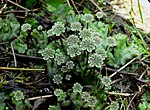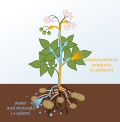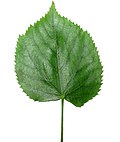Vascular plants (from Latin vasculum 'duct'), also called tracheophytes (UK: /ˈtrækiːəˌfaɪts/, US: /ˈtreɪkiːəˌfaɪts/) or collectively tracheophyta (/ˌtreɪkiːˈɒfɪtə/;...
23 KB (2,031 words) - 23:13, 8 November 2024
Non-vascular plants are plants without a vascular system consisting of xylem and phloem. Instead, they may possess simpler tissues that have specialized...
6 KB (637 words) - 04:05, 18 September 2024
Vascular tissue is a complex conducting tissue, formed of more than one cell type, found in vascular plants. The primary components of vascular tissue...
4 KB (459 words) - 19:11, 28 July 2024
Bryophyte (redirect from Non-vascular land plant)
group of land plants (embryophytes), sometimes treated as a taxonomic division, that contains three groups of non-vascular land plants: the liverworts...
35 KB (3,518 words) - 08:15, 29 October 2024
Pteridophyte (redirect from Seedless vascular plant)
A pteridophyte is a vascular plant (with xylem and phloem) that reproduces by means of spores. Because pteridophytes produce neither flowers nor seeds...
17 KB (1,655 words) - 18:04, 19 June 2024
Embryophyte (redirect from Land plant)
non-vascular land plants, namely the mosses (Bryophyta), hornworts (Anthocerotophyta), and liverworts (Marchantiophyta), are relatively small plants, often...
41 KB (3,854 words) - 01:24, 14 November 2024
Herbaceous plants are vascular plants that have no persistent woody stems above ground. This broad category of plants includes many perennials, and nearly...
14 KB (1,577 words) - 05:58, 7 July 2024
The vascular cambium is the main growth tissue in the stems and roots of many plants, specifically in dicots such as buttercups and oak trees, gymnosperms...
8 KB (945 words) - 11:01, 5 July 2024
A stem is one of two main structural axes of a vascular plant, the other being the root. It supports leaves, flowers and fruits, transports water and dissolved...
18 KB (2,215 words) - 18:47, 18 October 2024
Botany (redirect from Plant biology)
000 species of land plants, including some 391,000 species of vascular plants (of which approximately 369,000 are flowering plants) and approximately 20...
138 KB (14,773 words) - 09:08, 30 October 2024
Flora of Australia (redirect from Australian native plant)
Australia comprises a vast assemblage of plant species estimated to over 21,000 vascular and 14,000 non-vascular plants, 250,000 species of fungi and over 3...
45 KB (4,815 words) - 12:36, 23 October 2024
Royal Botanic Gardens, Kew (redirect from World Checklist of Vascular Plants)
seed plant families. WCSP is widely used, and most authoritative web resources on plants use it as their basis. The World Checklist of Vascular Plants (WCVP)...
16 KB (1,607 words) - 17:24, 8 November 2024
A vascular bundle is a part of the transport system in vascular plants. The transport itself happens in the stem, which exists in two forms: xylem and...
4 KB (352 words) - 05:19, 8 November 2024
Root (redirect from Plant roots)
In vascular plants, the roots are the organs of a plant that are modified to provide anchorage for the plant and take in water and nutrients into the...
51 KB (5,898 words) - 10:54, 5 November 2024
evidence of an embryophytic affinity. Trilete spores similar to those of vascular plants appear soon afterwards, in Upper Ordovician rocks about 455 million...
140 KB (17,348 words) - 23:49, 15 November 2024
Arbuscular mycorrhiza (redirect from Vascular arbuscular mycorrhiza)
(AM fungi, or AMF) penetrates the cortical cells of the roots of a vascular plant forming arbuscules. Arbuscular mycorrhiza is a type of endomycorrhiza...
95 KB (11,457 words) - 05:59, 13 November 2024
stays the same. Most plants are multicellular. Plant cells differentiate into multiple cell types, forming tissues such as the vascular tissue with specialized...
95 KB (8,067 words) - 16:08, 5 November 2024
Fern (section Fern-like flowering plants)
The ferns (Polypodiopsida or Polypodiophyta) are a group of vascular plants (plants with xylem and phloem) that reproduce via spores and have neither...
61 KB (5,954 words) - 15:22, 20 November 2024
Electro-osmosis (section Vascular plant biology)
drag water molecules from one side (anode) to the other (cathode). In vascular plant biology, electro-osmosis is also used as an alternative or supplemental...
16 KB (1,974 words) - 14:57, 20 October 2024
Stele (biology) (redirect from Vascular cylinder)
In a vascular plant, the stele is the central part of the root or stem containing the tissues derived from the procambium. These include vascular tissue...
7 KB (926 words) - 10:18, 18 May 2024
and organized by plant anatomy and function in plant physiology. This glossary primarily includes terms that deal with vascular plants (ferns, gymnosperms...
82 KB (10,361 words) - 14:43, 23 August 2024
Cortex (botany) (category Plant anatomy)
is an outer layer of a stem or root in a vascular plant, lying below the epidermis but outside of the vascular bundles. The cortex is composed mostly of...
4 KB (482 words) - 18:56, 22 September 2024
been predictable on the basis of examination of the separate parts." A vascular plant begins from a single celled zygote, formed by fertilisation of an egg...
26 KB (3,267 words) - 18:45, 18 October 2024
List of model organisms (section Vascular plants)
moellendorffii, remnant of an ancient lineage of vascular plants that is key to understanding the evolution of land plants. It has a small genome size (~110Mb) and...
46 KB (4,626 words) - 23:40, 15 June 2024
are terrestrial vascular plants; like the gymnosperms, they have roots, stems, leaves, and seeds. They differ from other seed plants in several ways....
80 KB (6,327 words) - 22:20, 19 November 2024
Phloem (category Plant anatomy)
Phloem (/ˈfloʊ.əm/, FLOH-əm) is the living tissue in vascular plants that transports the soluble organic compounds made during photosynthesis and known...
19 KB (2,325 words) - 00:47, 10 November 2024
Moss (redirect from Moss (plant))
Mosses are small, non-vascular flowerless plants in the taxonomic division Bryophyta (/braɪˈɒfətə/, /ˌbraɪ.əˈfaɪtə/) sensu stricto. Bryophyta (sensu lato...
61 KB (6,979 words) - 08:33, 19 October 2024
Leaf (redirect from Plant leaves)
A leaf (pl.: leaves) is a principal appendage of the stem of a vascular plant, usually borne laterally above ground and specialized for photosynthesis...
113 KB (11,734 words) - 04:23, 26 October 2024
This is a complete and as of 2009 up-to-date list of vascular plants listed in the Red Data Book of the Russian Federation and protected in Russia at...
29 KB (2,646 words) - 10:59, 12 November 2024
Flora of Great Britain and Ireland (redirect from List of the vascular plants of Britain and Ireland)
plants (Magnoliopsida): List of the vascular plants of Britain and Ireland (dicotyledons) List of the vascular plants of Britain and Ireland (Rosaceae)...
3 KB (370 words) - 13:19, 6 July 2023
























